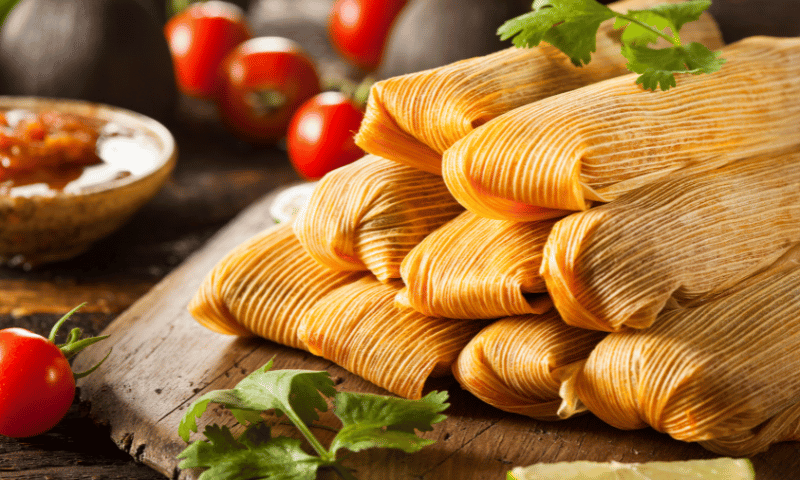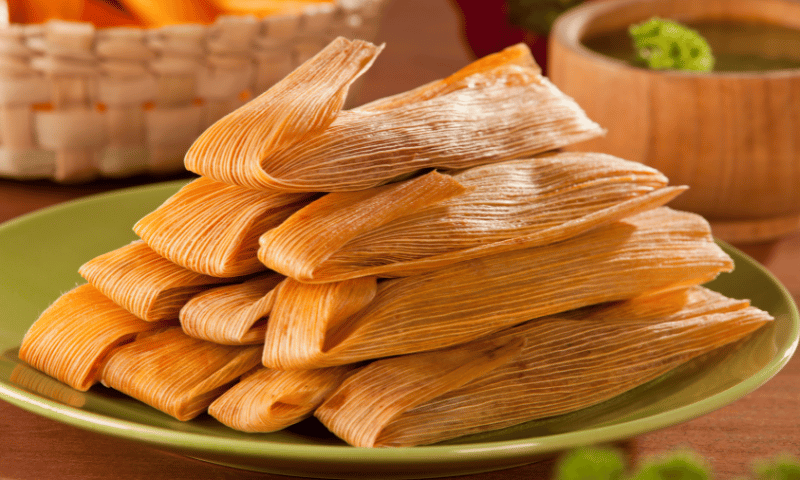Tamales can be part of a weight loss diet if consumed in moderation. They vary in nutritional content based on ingredients and portion size.
Tamales, a traditional Mesoamerican dish made with masa (a dough made from corn), can be a comforting and satisfying food choice. Typically, they include a filling of meats, cheeses, fruits, vegetables, or chilies, and are steamed in a corn husk or banana leaf.
The nutritional value of tamales is largely dependent on the fillings and preparation methods used. With a balance of carbohydrates, proteins, and fats, they can provide energy and satiety. However, their calorie content and macronutrients can vary, so choosing lean proteins and vegetable fillings, along with portion control, is crucial for those watching their weight. Enjoyed in moderation and as part of a balanced diet, tamales can definitely fit into a weight loss regimen.
The Tamale Tradition
Exploring the world of tamales unveils a delicious way to enjoy traditional flavors. Whether aiming for weight loss or savoring cultural delights, tamales stand out as a scrumptious option. Let’s delve into the roots and cultural importance of this beloved dish.
Origins And Ingredients
The story of tamales begins in Mesoamerica, thousands of years ago. Esteemed as food for the gods, their creation was an art form. Tamales are steamed bundles of joy, typically made with masa, a dough from ground corn. They often contain a filling like meats, cheese, or vegetables. Each tamale is lovingly wrapped in a corn husk or banana leaf. These wrappings are not just for cooking, but act as a plate too!
| Component | Ingredient |
| Dough | Masa, broth, oil or lard, salt, baking powder |
| Filling | Meat, cheese, vegetables, chilies, or fruits |
| Wrapper | Corn husks or banana leaves |
Cultural Significance
In many cultures, tamales symbolize more than food—they’re a part of history and community. In Mexican households, making tamales is a festive event called a tamalada, where family and friends gather to spread the dough, fill, and wrap tamales together. This tradition binds people and passes down culinary skills. Not only are tamales a staple for everyday meals, but they also feature during special celebrations like Christmas and Dia de los Muertos.
- Community Bonding: Tamaladas bring people together.
- Historical Significance: Tamales date back to ancient civilizations.
- Festive Foods: Essential during holidays and celebrations.
Nutritional Profile Of Tamales
Understanding the nutritional content of tamales can shed light on their role in a weight loss diet. Tamales, a traditional Mesoamerican dish made of masa (a dough made from nixtamalized corn), are often filled with meats, cheeses, or even fruits and vegetables. The healthiness of tamales varies widely based on ingredients and preparation methods, making the nutritional profile quite diverse.
Caloric Content
The calories in tamales can impact your weight loss goals. A single homemade tamale averages between 200 to 250 calories. Store-bought versions may contain more due to added fats and preservatives. Consuming them in moderation is key.
Macronutrients Breakdown
| Macronutrient | Amount per Average Tamale |
| Proteins | 10g |
| Fats | 10g-15g |
| Carbohydrates | 20g-30g |
Proteins in tamales come from meat or cheese fillings. Fats may be higher if lard is used in the masa or filling. The carbohydrates mainly from the masa provide energy. Fiber content can be beneficial for weight control, provided by additional ingredients such as beans or vegetables.
Weight Loss Basics
Embarking on a weight loss journey often brings forth a mix of emotions and questions.
One key question is whether or not tamales can fit into your diet as you aim to shed pounds.
Understanding the fundamentals of weight loss is essential before diving into specific foods and recipes, like tamales.
Let’s explore the basics of weight loss that will pave the way to answering this tasty question.
Energy Balance
The concept of energy balance is straightforward:
- Burn more calories than you consume to lose weight.
- Consume more than you burn to gain weight.
- Maintain an equal balance for weight stability.
Tamales, like any other food, contain calories that contribute to this daily balance.
Understanding their caloric content plays a major role in their impact on your weight loss goals.
Role Of Macronutrients
Macronutrients are the building blocks of our diet:
- Protein helps build and repair tissues, crucial for recovery.
- Fats serve as an energy source and support cell function.
- Carbohydrates provide energy to fuel daily activities and exercise.
Each macronutrient also affects satiety levels, which can influence overall calorie intake.
Tamales contain a mix of these macros, making their balancing act pertinent to weight management.

The Role Of Tamales In Diets
When it comes to weight loss, balance and moderation are key. Tamales, traditional Mesoamerican dishes wrapped in corn husks, can fit into a diet if approached correctly. They offer nutritional value such as protein, fiber, and essential vitamins, but they also come with calories. Understanding how tamales play into weight management demands a look at portion sizes and ingredients.
Tamales In Moderation
Portion control is crucial for weight loss. One tamale can be a satisfying and nutritious component of a meal when paired with vegetables or a salad. Tamales become less diet-friendly if consumed in large amounts, primarily because they’re often filled with meat and made with dough mixed with fat, which raises the calorie count.
- Incorporate tamales into a balanced meal plan.
- Limit intake to one or two tamales per meal.
Homemade Vs. Store-bought
Homemade tamales offer more control over what goes into them. You can use healthier ingredients such as low-fat cheese, lean meats, and fresh vegetables. Moreover, you can adjust the size to keep calories in check.
| Homemade Tamales | Store-Bought Tamales |
| Adjustable ingredients | Fixed recipe |
| Control over portion size | Standardized portions |
| Lower in preservatives | May contain preservatives |
With store-bought tamales, you get convenience, but often at a nutritional cost. They might contain more sodium and preservatives to extend their shelf life. Reading labels is essential to choose wisely and stay within dietary goals.
Common Misconceptions
When on a journey to lose weight, many people overlook tamales. This Mexican staple faces unfounded misconceptions. Let’s debunk some myths and see how tamales fit into a weight loss diet.
Carb-heavy Equals Bad?
Many assume all carbs sabotage weight loss. This isn’t true. Tamales contain complex carbohydrates. These carbs provide long-lasting energy. Choosing whole-grain versions can be even better. They have more fiber. Fiber helps you feel full longer. It’s not about cutting carbs but choosing the right type.
Misjudging Portion Sizes
With any food, portion control is key for weight loss. Tamales can have varying sizes and fillings. One common mistake is eating too many because they seem small. An ideal portion is usually one or two tamales, depending on their size and ingredients. Include a salad or veggies for a balanced meal.
Healthy Tamale Alternatives
Exploring healthy tamale alternatives is exciting for weight loss. Tamales are a traditional dish, often filled with meats and cheeses. But, healthier versions exist that are just as delicious. These alternatives use low-calorie ingredients and cater to vegetarian and vegan diets.
Low-calorie Ingredients
Selecting the right ingredients can make tamales a healthy choice. Think about using lean proteins like chicken or turkey. Add plenty of vegetables, like peppers and zucchini, to ramp up the fiber without the fat.
- Lean meats – Less fat, fewer calories
- Whole-grain masa – More nutrients, better for weight control
- Fresh vegetables – Add flavor, color, and fiber
Vegetarian And Vegan Options
Removing meat doesn’t mean removing taste. Black beans and lentils are great protein substitutes. Utilize spices and herbs to pack a flavorful punch. Tofu and tempeh are also excellent for a satisfying bite.
| Ingredient | Benefit |
| Black beans | Protein without the fat |
| Lentils | Fill you up, not out |
| Spices & Herbs | Boost flavor, zero calories |

Frequently Asked Questions Of Are Tamales Good For Weight Loss
Are Tamales High In Calories?
Tamales’ calorie content varies depending on the ingredients used. Traditional beef tamales can contain around 200–250 calories each. Choosing lean meats or vegetable fillings could reduce calorie intake, making them more suitable for weight loss.
Can Tamales Be Part Of A Healthy Diet?
Yes, tamales can be part of a healthy diet when consumed in moderation. Opt for tamales with healthy fillings, such as lean proteins and vegetables, and limit the use of high-calorie sauces to maintain a balanced diet.
Do Tamales Contain Beneficial Nutrients?
Tamales can provide nutrients such as protein, fiber, and vitamins, especially when filled with vegetables, beans, or lean meats. However, nutrient content significantly depends on the specific ingredients and preparation methods used.
How Many Tamales Should I Eat If Dieting?
Portion control is key when dieting. If including tamales in your weight loss plan, limit yourself to one or two, ensuring they are prepared with healthy ingredients and are part of a balanced meal.
Conclusion:
Wrapping up, tamales can play a role in weight management when enjoyed in moderation. Their high fiber and protein contribute to feeling full. Yet, careful consideration of ingredients is crucial to ensure they fit into a calorie-controlled diet. Savor the taste, but keep balance in mind for a healthy lifestyle.




Leave a Reply